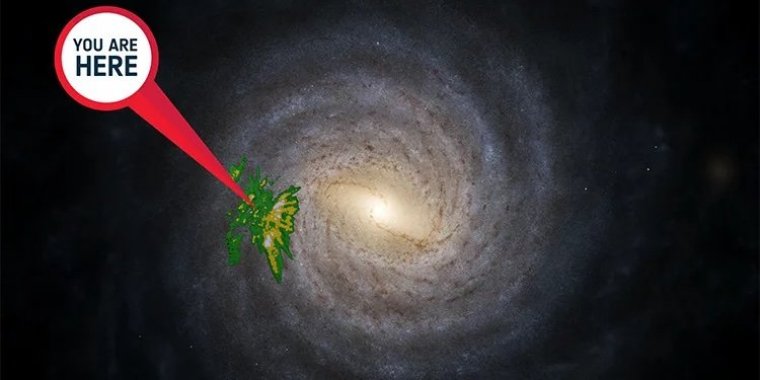| News / Science News |
Largest chemical map of the Milky Way unveiled
Gaia is ESA’s mission to create the most accurate and complete multi-dimensional map of the Milky Way. This allows astronomers to reconstruct our home galaxy’s structure and past evolution over billions of years, and to better understand the lifecycle of stars and our place in the Universe.

Artistic impression of the Milky Way. Photo: ESA/Gaia/DPAC
Gaia’s Data Release 3 (Gaia DR3) contains new and improved details for almost two billion stars in our galaxy. The catalogue includes new information including chemical compositions, stellar temperatures, colours, masses, ages, and radial velocities - the speed at which stars move towards or away from us.
Much of this information was revealed by newly released spectroscopy data, a technique in which starlight is split into its constituent colours, like a rainbow. The data also includes special subsets of stars, like those that change brightness over time.
Also new in this data set is the largest catalogue yet of binary stars, thousands of Solar System objects such as asteroids and moons of planets, and millions of galaxies and quasars outside the Milky Way.
“This release represents a major step forward in our creation of a detailed census of our Milky Way, fully characterising a significant sample of its stellar constituents,” said Dr Nic Walton from Cambridge’s Institute of Astronomy, and member of the ESA Gaia Science Team.
“Analogous to the 100,000 Genomes project in biology, we are now able to type hundreds of millions of stars, which enables us to accurately determine the life cycles from birth to death of those stars, and the incredible history and future of our Milky Way.”
What stars are made of can tell us where they come from and where they’ve been, and therefore about the history of the Milky Way. With this data release, Gaia is revealing the largest chemical map of the galaxy coupled to 3D motions, from our solar neigbourhood to smaller galaxies surrounding ours.
Some stars contain more heavy metals than others. During the Big Bang, only light elements – hydrogen and helium – were formed. All other heavier elements – called metals by astronomers – are built inside stars.
When stars die, they release these metals into the gas and dust between the stars called the interstellar medium, out of which new stars form.
Active star formation and death will lead to an environment that is richer in metals. A star’s chemical composition is a bit like its DNA, giving us crucial information about its origin.
With Gaia, we see that some stars in our galaxy are made of primordial material, while others like our Sun are made of matter enriched by earlier generations of stars. Stars that are closer to the centre of our galaxy are richer in metals than stars at larger distances.
Gaia also identified stars that originally came from different galaxies than our own, based on their chemical composition.
“The more stars we know the chemistry for, the better we can understand our galaxy as a whole,” said Dr George Seabroke from UCL Mullard Space Science Laboratory.
“Gaia’s chemical catalogue of six million stars is ten times larger than previous ground-based catalogues, so this is revolutionary. Gaia’s data releases are telling us where stars were located and how they are moving. Now we also know what a lot of these stars are made of.”
The data also includes special subsets of stars, like those that change brightness over time. As well as chemical compositions and radial velocities, the catalogue includes new information about stellar ages, masses, temperatures and colours.
Low-resolution spectra for about 220 million sources will be made available to the astronomy community as part of DR3.
One of the most surprising discoveries coming out of the new data is that Gaia can detect starquakes – tiny motions on the surface of a star – that change the shapes of stars, something the observatory was not originally built for.
Previously, Gaia already found radial oscillations that cause stars to swell and shrink periodically, while keeping their spherical shape. But Gaia has now also spotted other vibrations that are more like large-scale tsunamis.
These nonradial oscillations change the global shape of a star and are therefore harder to detect.
A new binary star catalogue presents the mass and evolution of more than 800 thousand binary systems, while a new asteroid survey comprising 156,000 rocky bodies is digging deeper into the origin of our Solar System.
Gaia is also revealing information about 10 million variable stars, mysterious macro-molecules between stars, as well as quasars and galaxies beyond our own cosmic neighbourhood.
“Unlike other missions that target specific objects, Gaia is a survey mission,” said Dr Timo Prusti, Project Scientist for Gaia at ESA.
“This means that while surveying the entire sky with billions of stars multiple times, Gaia is bound to make discoveries that other more dedicated missions would miss. This is one of its strengths, and we can’t wait for the astronomy community to dive into our new data to find out even more about our galaxy and its surroundings than we could’ve imagined.” (University of Cambridge)





